On this page
AEWA Technical SeriesThis page lists the technical series publications under the banner of the African-Eurasian Waterbird Agreement (AEWA).The majority of this series can be downloaded from the AEWA website.
AEWA pagesThere are two AEWA related pages on the site:
Technical Series
Popular Series
AEWAAEWA is an intergovernmental treaty dedicated to the conservation of migratory waterbirds and their habitats across Africa, Europe, the Middle East, Central Asia, Greenland and the Canadian Archipelago.Developed under the framework of the Convention on Migratory Species (CMS) and administered by the United Nations Environment Programme (UNEP), AEWA brings together countries and the wider international conservation community in an effort to establish coordinated conservation and management of migratory waterbirds throughout their entire migratory range.
|
|
|
|
International Single Species Action Plan for the Conservation of the Shoebill Balaeniceps rexCompiled by Tim Dodman
Technical Series No. 51
AEWA
2013
Prepared by Nature Uganda With financial support from the Federal Office for the Environment, Switzerland and with in-kind support from the Ministry of Tourism, Wildlife and Antiquities, Uganda.
From the executive summary: "The Shoebill is a large unique waterbird confined to a rather restricted set of generally extensive freshwater swamps of eastern central tropical Africa. It thus has a fragmented distribution bound to this habitat and a low population, estimated at 5,000 - 8,000 birds. As the Shoebill has clearly been in decline in several areas, it is listed as Vulnerable in the IUCN Red List. The Shoebill occurs from South Sudan and Ethiopia in the north to northern Zambia in the south. It is resident in South Sudan, western Ethiopia, Uganda, Rwanda, eastern Democratic Republic of the Congo, western Tanzania and northern Zambia, with records also from Central African Republic, Burundi and Kenya."
|
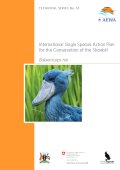 |
|
International Species Management Plan for the Svalbard Population of the Pink-footed Goose Anser brachyrhynchusCompiled by Jesper Madsen & James H. Williams
Technical Series No. 48
AEWA
2012
Prepared by The Aarhus University, Roskilde, Denmark. Prepared and printed with financial support from The Norwegian Directorate for Nature Management.
From the executive summary: "The African-Eurasian Waterbird Agreement (AEWA) calls for means to manage populations which cause conflicts with certain human economic activities. The Svalbard population of the Pink-footed Goose Anser brachyrhynchus has been selected as the first test case for such an international species management plan to be developed. The Pink-footed Goose is classified as having a 'Favourable Conservation Status' within Europe and a species of 'Least Concern' using IUCN's global Red List criteria. Numbers of the Svalbard-breeding population of Pink-footed Goose, although the smaller of the two biogeographical populations, have increased considerably over the past decades, reaching an estimated population size of 69,000 individuals in 2010. The continued growth of the Svalbard population is a conservation success story, yet its increasing population size, along with other goose species, has progressively brought them into conflict with agricultural interests as well as having other environmental and social implications."
|
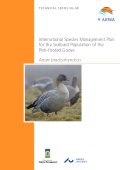 |
|
International Single Species Action Plan for the Conservation of the
Sociable Lapwing Vanellus gregariusCompiled by Rob Sheldon, Maxim Koshkin, Johannes Kamp, Sergey Dereliev, Paul Donald & Sharif Jbour
Technical Series No. 47
AEWA
(CMS Technical Series No. 28)
2012
Prepared with financial support from the UK Government's Darwin
Initiative and Swarovski Optik through Birdlife International's Preventing Extinctions Programme.
From the executive summary: "The Sociable Lapwing (Vanellus gregarius) is globally threatened, being recognized as Critically Endangered by IUCN. It is listed in Column A of the action plan under the African-Eurasian Migratory Waterbird Agreement (AEWA) and in Annex I of the Convention on Migratory Species (CMS). The Sociable Lapwing is a migratory species. It breeds in the central steppes of Kazakhstan with small numbers in Russia. The majority of the population migrate through south-west Russia, into Turkey and through a number of countries in the Middle East, before spending the winter in north-east Africa and the Arabian Peninsula. A small number of birds migrate south-east into Pakistan and north-west India."
|
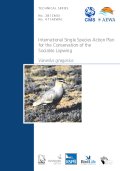 |
|
International Single Species Action Plan for the Conservation of the
Red-breasted Goose Branta ruficollisCompiled by Peter Cranswick, Lavinia Raducescu, Geoff Hilton, Nicky Petkov
Technical Series No. 46
AEWA
2012
Prepared by the Wildfowl & Wetlands Trust, UK.
From the executive summary: "The Red-breasted Goose is a globally threatened species. It is classified as Endangered on the IUCN Red List. The species suffered a large and rapid decline in population size following 2000, and is now highly concentrated at a relatively low number of sites, increasing its vulnerability to threats. It is assigned a high level of protection under international environmental agreements and legislations . The Red-breasted Goose breeds in Arctic Russia and migrates in winter around the northern and western coasts of the Black Sea. It occurs almost entirely in five countries - Bulgaria, Kazakhstan, Roman ia, the Russian Federation and Ukraine – which therefore have a special responsibility for the conservation of the species."
|
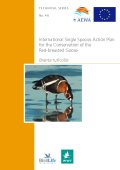 |
|
International Single Species Action Plan for the Conservation of the Greenland White-fronted Goose Anser albifrons flavirostrisCompiled by David Stroud, Tony Fox, Christine Urquhart & Ian Francis
Technical Series No. 45
AEWA
2012
Prepared with funding from Scottish Natural Heritage.
|
 |
|
International Single Species Action Plan for the Conservation of the Northwest European Population of the Bewick's Swan Cygnus columbianus bewickiiCompiled by Szabolcs Nagy, Nicky Petkov, Eileen Rees, Alexander Solokha, Geoff Hilton, Jan Beekman and Bart Nole
Technical Series No. 44
AEWA
2012
Prepared by Wetlands International and The Wildfowl & Wetland s Trust (WWT) with funding from The BBI-MATRA Programme of the former Dutch Ministry of Agriculture, Nature and Food Quality (currently Dutch Ministry of Economic Affairs, Agriculture and Innovation) and the Dutch Ministry of Foreign Affairs.
From the executive summary: "The Tundra Swan (Cygnus columbianus), of which the Bewick's Swan (Cygnus columbianus bewickii) is the Palearctic subspecies, has a global conservation status of Least Concern (BirdLife International 2010) . However, the status of the species is considered as Vulnerable in Europe (BirdLife International 2004). The species is included in Appendix II of the Convention on the Conservation of the European Wildlife and Natural Habitats (Bern Convention), in Appendix II of the Convention on Migratory Species (CMS or Bonn Convention). It is also listed in category A(3) c of the African Eurasian Waterbird Agreement and in Annex I of the EU Birds Directive."
|
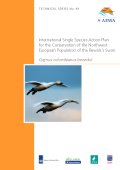 |
|
International Single Species Action Plan for the Conservation of the Slaty Egret Egretta vinaceigulaCompiled by Stephanie J. Tyler
Technical Series No. 43
AEWA
2012
|
 |
|
Review of the Conflict Between Migratory Birds and Electricity Power Grids in the African-Eurasian RegionCompiled by Hein Prinsen, Gerard Boere, Nadine Píres & Jon Smallie
Technical Series No. 42
AEWA
2011
|
 |
|
Report on the Conservation Status of Migratory Waterbirds in the Agreement Area: 5th EditionSimon Delany, Stephan Flink, Tom Langendoen, Szabolcs Nagy, Marc van Roomen, Erik van Winden, Jonas Sundberg, Ross Wanless, Stuart Butchart, Tim Dodman, Derek Scott
Technical Series No. 41
AEWA
2011
Report prepared by Wetlands International
|
 |
|
International Single Species Action Plan for the Conservation of the
Madagascar Pond-heron Ardeola idaeCompiled by Paul Kariuki Ndang'ang'a and Eric Sande
Technical Series No. 39
AEWA
(CMS Technical Series No. 20)
2008
Prepared with funding from the Italian Ministry for the Environment, Land and Sea.
From the executive summary: "The Madagascar Pond-heron Ardeola idae is listed as Endangered in the IUCN Red List. This is because it has a very small population (estimated at 2,000–6,000 individuals) which is undergoing a continuing decline. Whilst it remains fairly widespread in Madagascar, populations are low. It breeds from October to March in Madagascar, Aldabra (Seychelles), Mayotte (eastern Comoro Island, France) and Europa (Iles Eparses, administered from Réunion, to France). It has a large non-breeding range in Central and East Africa including the Comoro Islands, Mozambique, Zimbabwe, Zambia, Malawi, the United Republic of Tanzania, Kenya, Uganda, Burundi, Rwanda and the Democratic Republic of Congo; and is also a vagrant in Angola and Somalia."
|
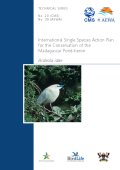 |
|
International Single Species Action Plan for the Conservation of the
White-winged Flufftail Sarothrura ayresiCompiled by The Africa Partnership Secretariat of BirdLife InternationalEdited by: Eric Sande, Paul Kariuki Ndang 'ang 'a, James Wakelin, Mengistu Wondafrash, Malcolm Drummond and Sergey Dereliev
Technical Series No. 38
AEWA
(CMS Technical Series No. 19)
2008
Funded by The Italian Ministry for the Environment, Land and Sea. Produced by BirdLife International Africa Partnership Secretariat
in cooperation with Ethiopian Wildlife and Natural History Society, Middelpunt Wetland Trust and Ezemvelo KZN Wildlife.
From the executive summary: "The White-winged Flufftail Sarothrura ayresi is a globally threatened species (IUCN Red List category: Endangered), with a declining population estimated at 700 individuals. It occurs in Ethiopia (at three sites, the only known breeding sites), Zimbabwe (three records) and South Africa (known from nine sites). The main threats to the White-winged Flufftail include grazing and cutting of sedges and grasses during the breeding season; increased transformation of natural habitat to cultivation; inundation of wetland habitat through the construction of dams; natural resource use by local people; habitat trampling by livestock; and afforestation with eucalyptus. There is limited information on the population status and ecology of the species, which hampers implementable conservation action."
|
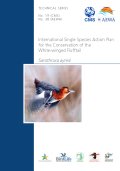 |
|
International Single Species Action Plan for the Conservation of the
Black-tailed Godwit Limosa l. limosa & L. l. islandicaCompiled by Flemming Pagh Jensen, Arnaud Béchet and Eddy Wymenga
Technical Series No. 37
AEWA
2008
Prepared and printed with funding from Vogelbescherming Nederland (BirdLife Netherlands). This AEWA SSAP is based on the EU Management Plan for the Black-tailed Godwit of 2007, which was updated with newly available information and extended to flyway scale.
From the executive summary: "The Black-tailed Godwit has a widespread but disjunct distribution in the Western Palearctic. Two subspecies occur in this area; islandica which breeds mainly in Iceland and limosa with a main breeding range from The Netherlands to Russia. The populations of both subspecies are migratory and have separated migration systems. In the European part of the migration system, subspecies can mix. The species increased during the 20th century throughout the Western Palearctic but while the islandica population has continued to increase in numbers and expanded its breeding range, nominate limosa's has shown range contraction and major declines in most key breeding areas during the last decades. Today the islandica population numbers c.25,000 pairs while the nominate population of the Western Palearctic totals c.110,000 pairs. About 50% of the nominate population breeds in The Netherlands. Due to the continuing decline of nominate Black-tailed Godwits, its status on the IUCN Red List of Threatened Species was changes in 2006 from 'Least Concern' to 'Near Threatened'."
|
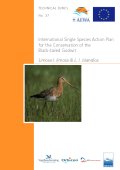 |
|
International Single Species Action Plan for the Conservation of the
Lesser White-fronted Goose (Western Palearctic Population) Anser erythropusCompiled by Tim Jones, Kirsten Martin, Boris Barov & Szabolcs Nagy
Technical Series No. 36
AEWA
2008
Prepared with financial support from: the Ministry of the Environment of Finland; the Federal Ministry for the Environment, Nature Conservation and Nuclear Safety; the Directorate for Nature Management of Norway; and
the Swedish Environmental Protection Agency.
From the executive summary: "The Lesser White-fronted Goose Anser erythropus is globally threatened, being recognised as Vulnerable by IUCN and ranked by BirdLife International as 'SPEC 1' within Europe, denoting a European species of global conservation concern. It is listed on Annex 1 of the European Council Directive on the conservation of Wild Birds (79/409/EEC, 2 April 1979), in Column A of the Action Plan under the African-Eurasian Migratory Waterbird Agreement (AEWA) and in Annex II 'Strictly protected species' of the Bern Convention. Lesser White-fronted Geese are long-distance Palearctic migrants, currently breeding discontinuously in the sub-arctic zone from northern Fennoscandia to eastern Siberia. The wintering/staging areas and migration routes are only partially known."
|
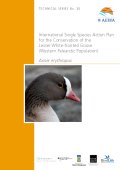 |
|
International Single Species Action Plan for the Conservation of the Eurasian Spoonbill Platalea leucorodia Compiled by Patrick Triplet, Otto Overdijk, Michael Smart, Szabolcs Nagy, Martin Schneider-Jacoby, E. Sühendan Karauz, Csaba Pigniczki, Sherif Baha El Din, Jelena Kralj, Attila Sandor, Juan G. Navedo
Technical Series No. 35
AEWA
2008
Prepared and printed with funding from Vogelbescherming Nederland (BirdLife Netherlands).
From the executive summary: "The Eurasian Spoonbill Platalea leucorodia is distributed from the East Atlantic to India and China. Four or five populations/subspecies can be distinguished: Platalea leucorodia leucorodia, the nominate subspecies, is distributed from Western to Central Europe/Southeast Europe. It is often separated into two populations, the Atlantic and Central/Southeast European, differing in their distribution and ecology, in particular during the breeding season. The population which breeds in eastern Europe and throughout Asia has been designated as a separate subspecies, Platalea leucorodia major on the basis that it is larger in size than the nominate subspecies. Two subspecies are found in Africa, P. l. balsaci whose distribution is limited to the Banc d'Arguin (Mauritania) and P. l. archeri, the Spoonbill of the Red Sea. These two populations are not migratory and mix with Eurasian Spoonbills during the winter."
|
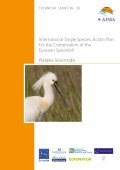 |
|
International Single Species Action Plan for the Conservation of the
Lesser Flamingo Phoeniconaias minorCompiled by Brooks Childress, Szabolcs Nagy and Baz Hughes
Technical Series No. 34
AEWA
(CMS Technical Series No. 18)
2008
Produced by IUCN-SSC/Wetlands International Flamingo Specialist Group, Wildfowl & Wetlands Trust, Wetlands International, BirdLife International Africa Partnership. Prepared with financial support from: Swedish Environmental Protection Agency, Wildfowl & Wetlands Trust, International Flamingo Foundation, Disney Animal Programs, Taiwan Council of Agriculture, Wetlands International, Pensthorpe Conservation Trust, Hillside Bird Oasis, The Friends of Banham Zoo, Flamingo Land. Printed with support from: IUCN-SSC/Wetlands International Flamingo Specialist Group.
From the executive summary: "The Lesser Flamingo is an itinerant species adapted to respond to changes in local environmental conditions by moving among wetlands, and thus depends on a network of suitable sites. Four separate populations are recognised for conservation purposes, although it is assumed that some interchanges probably occur among them. The largest population, estimated to be 1.5-2.5 million individuals, occurs on the alkaline-saline lakes of the Great Rift Valley in East Africa, where aggregations of several hundred thousand birds regularly provide one of the world 's most impressive wildlife spectacles. Smaller populations occur in the Rann of Kachchh in north-western India, estimated to be approximately 390,000 birds, in southern Africa, estimated to be 55,000 - 65,000 birds and in West Africa, estimated to be 15,000 - 25,000 birds. Declines have been suggested for much of Africa, but are difficult to clarify due to widescale movement within the continent. The Lesser Flamingo occurs regularly in 30 countries from West Africa, across sub-Saharan Africa and along the SW Asian coast to South Asia, and occurs as a vagrant in 26 additional countries. However, its global population is concentrated in 12 primary range states. Because of its specialized diet of microscopic alkaline cyanobacteria ('blue-green algae'), the Lesser Flamingo is totally dependent on a habitat of shallow saline/alkaline lakes, pans, wetlands and coastal areas, and >95% of its non-breeding population is concentrated at just 73 sites in the 12 primary range states."
|
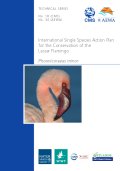 |
|
Update Report on the Use of Non-Toxic Shot for Hunting in WetlandsCompiled by Catherine Lehmann
Technical Series No. 33
AEWA
2008
Prepared by the UNEP/AEWA Secretariat.
From the executive summary: "This update report on the use of non-toxic shot for waterbird hunting reviews the progress made in phasing out lead shot for hunting in wetlands since the y ear 2000. It consists of five main sections: a review of conventions and agreements (chapter II) and international hunting organisations (chapter III) concerned with the issue; a description of the situation in individual countries (chapter IV); a literature review (chapter V) and conclusions and recommendations (chapter VI)."
|
 |
|
Review of the Status of Introduced Non-Native Waterbird Species in the Agreement Area of the African-Eurasian Waterbird Agreement
Technical Series No. 32
AEWA
2008
|
 |
|
Review Of Waterbird Re-Establishments In The Agreement AreaCompiled by: Rebecca Lee & Baz Hughes
Technical Series No. 31
AEWA
2008
Prepared by Wildfowl & Wetlands Trust.
|
 |
|
Review of the Implementation and the Effectivness of 15 Single Species Action Plans for Migratory Waterbird SpeciesCompiled by Umberto Gallo Orsi & Canan Orhun
Technical Series No. 30
AEWA
2008
Prepared by the UNEP/AEWA Secretariat.
|
 |
|
Review on Hunting and Trade Legislation in Countries Relating to the Species Listed in Annex 2 to the African-Eurasian Migratory Waterbird AgreementCompiled by Catherine Lehmann
Technical Series No. 29
AEWA
2008
From the executive summary: "The Agreement on the Conservation of African-Eurasian Migratory Waterbirds (AEWA) specifies actions for sustainable hunting of and trade in migratory waterbirds in its legally binding Action Plan, which result in a number of requirements related to hunting and trade legislation in the countries that are Party to AEWA."
|
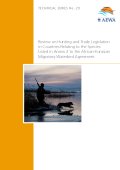 |
|
Guidelines On Measures Needed To Help Waterbirds To Adapt To Climate Change Compiled by Catherine Lehmann
Conservation Guidelines No. 12
Technical Series No. 27
AEWA
2008
Funded by The Department for Environment, Food and Rural Affairs (DEFRA), United Kingdom. Produced by The British Trust for Ornithology (BTO) From the introduction: "Climate change is likely to affect all ecosystems, but wetlands are particularly vulnerable. They host a very high biological diversity, providing the water and primary productivity up on which countless species of plants and animals depend for survival. Waterbirds are the most widely used tool to identify, designate and justify the protection of important wetlands. Their sensitivity to environmental change, the relative ease with which they can be counted and their tendency to congregate at key locations make them effective proxies for aspects of wider biodiversity."
|
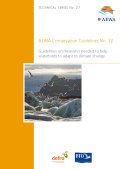 |
|
Guidelines On How To Avoid, Minimize Or Mitigate Impact Of Infrastructural Developments And Related Disturbance Affecting WaterbirdsCompiled by Dr. Graham Tucker and Dr. Jo Treweek
Conservation Guidelines No. 11
Technical Series No. 26
AEWA
2008
Funded by The Agency for Nature and Forests, Ministry of the Flemish Community (ANF), Belgium
From the introduction: "Infrastructure developments (e.g. dams, railways, roads, airports, mines, buildings, wind-turbines, powerlines and pipelines) are a major source of ecosystem damage and habitat loss, which can have a variety of impacts on waterbirds. Such impacts may also be exacerbated by the tendency for some waterbirds to congregate in large numbers, such as in breeding colonies or at migration and wintering sites. Furthermore, some migratory species rely on a network of a few specific sites along a flyway over their annual cycle. As a result a relatively high proportion of a flyway, or even a global population can be affected by impacts at congregatory sites. Compared with some other species groups, migratory waterbirds are more likely to be exposed to cumulative and trans-boundary effects which may need to be appraised at a strategic fly-way scale (Boere et al. 2006). Infrastructure developments therefore need to be carefully planned and implemented to avoid biodiversity losses and to ensure that viable populations of waterbird species can be maintained across their ranges."
|
 |
|
Review of the Status of Introduced Non-Native Waterbird Species in the Agreement Area of the African-Eurasian Waterbird Agreement
Technical Series No. 25
AEWA
2008?
|
 |
|
Guidelines For A Waterbird Monitoring ProtocolText: Albert Beintema, Dineke Beintema, Allix Brenninkmeijer, Simon Delany and Jeff KirbyEditing: Simon Delany and Derek Scott
Conservation Guidelines No. 9
Technical Series No. 24
AEWA
2005
Prepared by Wetlands International
From the introduction: "These guidelines are a summary of the waterbird monitoring practices at national level that are most appropriate for international conservation efforts. Conservation practitioners involved in waterbird monitoring at national level should follow the guidelines to enhance the quality of information available for international waterbird conservation."
|
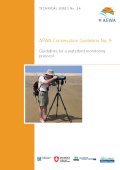 |
|
Guidelines On Reducing Crop Damage, Damage To Fisheries, Bird Strikes And Other Forms Of Conflict Between Waterbirds And Human ActivitiesText: Albert Beintema, Dineke Beintema, Allix Brenninkmeijer, Simon Delany and Jeff KirbyEditing: Simon Delany and Derek Scott
Conservation Guidelines No. 8
Technical Series No. 23
AEWA
2005
Prepared by Wetlands International
From the introduction: "Reducing damage by birds to crops, fisheries or aircraft can be a complex, lengthy and expensive process. Solutions will vary greatly between species, sites and countries. These guidelines should therefore be interpreted as a flexible code of conduct."
|
 |
|
Guidelines On The Development Of Ecotourism At WetlandsText: Albert Beintema, Dineke Beintema, Allix Brenninkmeijer, Simon Delany and Jeff KirbyEditing: Simon Delany and Derek Scott
Conservation Guidelines No. 7
Technical Series No. 22
AEWA
2005
Prepared by Wetlands International
From the introduction: "Tourism is an important source of income for many countries. Nature-related tourism is a world-wide phenomenon that is expanding rapidly. Nature-related tourism is only profitable in the long run if it is managed in a sustainable way. If the people benefiting from tourism come to realise this, tourism becomes a stimulus for nature conservation. As is said in park management in East Africa: 'Wildlife pays, so wildlife stays'."
|
 |
|
The Effects of Climate Change on Migratory Waterbirds within the African-Eurasian Flyways
Technical Series No. 21
AEWA
2005?
|
 |
|
Guidelines On Regulating Trade In Migratory WaterbirdsText: Albert Beintema, Dineke Beintema, Allix Brenninkmeijer, Simon Delany and Jeff KirbyEditing: Simon Delany and Derek Scott
Conservation Guidelines No. 6
Technical Series No. 20
AEWA
2005
Prepared by Wetlands International
From the introduction: "Accurate figures for the volume of trade in waterbirds are lacking, owing to the absence of comprehensive reporting requirements. The best available information is collected under CITES, the Convention on International Trade in Endangered Species of Wild Fauna and Flora. Recent CITES data provide some insights into the waterbird species subject to international trade, and also the types of trade taking place. When compared with the trade in cage birds (e.g. parrots and songbirds), only small numbers of migratory waterbirds are subject to international trade in the AEWA area. Much more significant, both from a species conservation and a socio-economic viewpoint, is trade in domestic markets. Some studies have reported that hundreds of thousands of waterbirds are traded in this way."
|
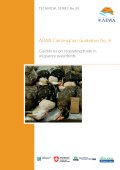 |
|
Guidelines On Sustainable Harvest Of Migratory WaterbirdsText: Albert Beintema, Dineke Beintema, Allix Brenninkmeijer, Simon Delany and Jeff KirbyEditing: Simon Delany and Derek Scott
Conservation Guidelines No. 5
Technical Series No. 19
AEWA
2005
Prepared by Wetlands International
From the introduction: "Migratory waterbirds provide an excellent resource for millions of people worldwide. Whilst many simply watch and study, others hunt them, either for sport, subsistence or to raise income in the market place (i.e. to trade). Exactly how many are taken for each purpose in the AEWA area is not known, but may in some places be very large and of considerable socio-economic importance. Hunting is a legitimate and traditional use of the rural environment, and hunters make important contributions to the conservation of waterbirds and other wildlife and habitats. Problems to avoid include over-exploitation or excessive disturbance, lead poisoning, the spread of exotic species and farm-reared stock, and the degradation of habitats through 'improvements' solely designed to increase harvesting opportunity."
|
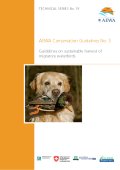 |
|
Guidelines On The Management Of Key Sites For Migratory WaterbirdsText: Albert Beintema, Dineke Beintema, Allix Brenninkmeijer, Simon Delany and Jeff KirbyEditing: Simon Delany and Derek Scott
Conservation Guidelines No. 4
Technical Series No. 18
AEWA
2005
Prepared by Wetlands International
From the introduction: "There is a tendency in nature conservation to abandon the sectoral approach (e.g. birds versus flowers), and to direct management towards the maintenance of healthy ecosystems, with a high degree of biodiversity. In truly natural systems, this is undoubtedly the best approach. However, migratory waterbirds often rely on areas that are intensively used by man for other purposes (e.g. geese in agricultural land). In these cases, an ecosystem approach would not work, and for the purposes of the AEWA, it is often necessary to revert to the sectoral approach. It is always important to recognise that the best way to approach the management of a particular site (sectoral versus ecosystem oriented) will differ from case to case, depending on the nature of the site."
|
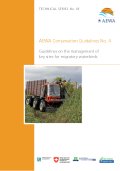 |
|
Guidelines On The Preparation Of Site Inventories For Migratory WaterbirdsText: Albert Beintema, Dineke Beintema, Allix Brenninkmeijer, Simon Delany and Jeff KirbyEditing: Simon Delany and Derek Scott
Conservation Guidelines No. 3
Technical Series No. 17
AEWA
2005
Prepared by Wetlands International
From the introduction: "An inventory of important sites is one of the basic tools for the conservation and management of migratory waterbirds. In order to protect or manage populations of migratory waterbirds, it is first necessary to locate and prioritise the sites, which they use throughout their flyway (breeding, moulting, staging and wintering areas). The importance of the site inventory is recognised in Paragraph 3.1.1 of the AEWA Action Plan, which requires Parties to undertake and publish national inventories of the habitats within their territory, which are important to the populations of waterbirds listed in Table 1 of the Action Plan."
|
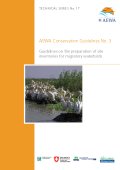 |
|
Guidelines On Identifying And Tackling Emergency Situations For Migratory WaterbirdsText: Albert Beintema, Dineke Beintema, Allix Brenninkmeijer, Simon Delany and Jeff KirbyEditing: Simon Delany and Derek Scott
Conservation Guidelines No. 2
Technical Series No. 16
AEWA
2005
Prepared by Wetlands International
From the introduction: "An emergency situation for migratory waterbirds is a situation where a sudden, unusual change takes place (or is likely to take place) in the occurrence or mortality rate of waterbirds, or in the extent or condition of the habitats on which they depend. While it might not always be possible to deal with such situations effectively, it is very important to react as publicly as possible to draw people's attention to the situation. Public awareness is of extreme importance, especially in the case of human-induced catastrophic events, because it may help to prevent similar events from happening in the future."
|
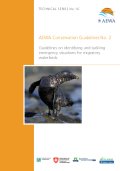 |
|
Guidelines On The Preparation Of National Single Species Action Plans For Migratory WaterbirdsText: Albert Beintema, Dineke Beintema, Allix Brenninkmeijer, Simon Delany and Jeff KirbyEditing: Simon Delany and Derek Scott
Conservation Guidelines No. 1
Technical Series No. 15
AEWA
2005
Prepared by Wetlands International
From the introduction: "A Single Species Action Plan (SSAP) is defined as a prescriptive plan for a species or a population of a species, aimed at maintaining that species in a favourable conservation status or restoring it to that status. Why do we need SSAPs? All over the world, there is a tendency towards a more ecosystem- oriented approach in nature conservation, as opposed to species-oriented protection. With the species-oriented approach, there is always the risk of favouring one species at the expense of other valuable species, possibly from other groups of animals or plants, of which the conservation body responsible for protection may not even be aware. However, some species cannot be adequately protected by ecosystem - or habitat-oriented measures alone. During migration, waterbirds may depend on locations that cannot be fully protected, or they may be particularly threatened by developments on their breeding grounds, at specific staging areas, or on their wintering grounds. Because migratory species cross national boundaries, it is essential that measures for the protection of these species and conservation of their habitats be co-ordinated at an international scale. Single Species Action Plans may help to achieve this co-ordination."
|
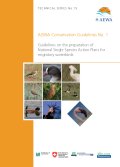 |
|
International Single Species Action Plan for the Conservation of the
Maccoa Duck Oxyura maccoaiCompiled by Y. D. Abebe, N. Baker, A. Berruti, D. Buijs, B.D. Colahan, C. Davies, J. Eksteen, S.W. Evans, H. Kolberg, A. Marchant, Z. Mpofu, P. Nantongo-Kalundu, P.Y. Nnyiti, K. Pienaar, K. Shaw, T. Tyali, J. van Niekerk, M.J. Wheele
Technical Series No. 14
AEWA
2007
Prepared in collaboration with The African Gamebird Research Education and Development Trust, BirdLife International Africa Division, BirdLife South Africa, Endangered Wildlife Trust.
"The International Single Species Action Plan for the Conservation of the Maccoa Duck (Oxyura maccoa) - gives an overview of the current status of the main populations of the Maccoa Duck remaining in Africa and identifies ways to better conserve them at both national and international level. Overall, the report shows that the conservation status of the Maccoa Duck is worse than previously understood and that more research and conservation actions are required to quantify the conservation risks. While the revised estimate of the total population presented in this report amounts to 9000-11750 birds and the southern population (Angola, Namibia, Botswana, Zimbabwe, South Africa and Lesotho) has now stabilised, the report also warns that the northern population (Ethiopia, Kenya, Tanzania and Eritrea) is in rapid decline."
|
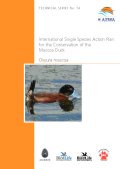 |
|
Report on the Conservation Status of Migratory Waterbirds in the Agreement AreaCompiled by Simon Delany, Derek A. Scott,
Toon Helmink & Georgios Martakis
Technical Series No. 13
AEWA
2007
Prepared by Wetlands International.
"The Report, prepared by Wetlands International on the Conservation Status of Migratory Waterbirds in the Agreement Area gives an overview of the current status of migratory waterbirds in the African-Eurasian region. It includes information on the size of the various populations, their breeding ranges, wintering distributions and migration routes, and the long-term trends in their population levels."
|
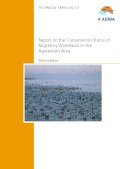 |
|
Guidelines on Avoidance of Introductions of non-native Waterbird SpeciesCompiled by Myrfyn Owen, Des Callaghan & Jeff Kirby
Technical Series No. 12
AEWA
2006
Prepared with co-funding from Department for Environment, Food and Rural Affairs, United Kingdom; Joint Nature Conservation Committee, United Kingdom; and World Association of Zoos and Aquariums.
"In Article III of the Agreement the Parties agree to 'prohibit the deliberate introduction of non-native waterbird species into the environment and [to] take all appropriate measures to prevent the unintentional release of such species if this introduction of release would prejudice the conservation status of wild flora and fauna; when non-native waterbird species have already been introduced the, the Parties shall take all appropriate measures to prevent these species from becoming a potential threat to indigenous species.'."
|
 |
|
International Single Species Action Plan for the Conservation of the Light-bellied Brent Goose Branta bernicla hrotaCompiled by James A. Robinson and Kendrew Colhoun
Technical Series No. 11
AEWA
2006
Prepared with the financial support of National Parks & Wildlife Service (Dublin), Environment & Heritage Service (Belfast), and the Wildfowl & Wetlands Trust.
From the executive summary: "The East Canadian High Arctic (ECHA) Light-bellied Brent Goose Branta bernicla hrota breeds in Canada's eastern Queen Elizabeth Islands with the great majority wintering on the coastline of the island of Ireland and smaller numbers on the Channel Islands and the northern coasts of France and Spain. It is protected under the general provisions of the European Union Directive on the Conservation of Wild Birds (79/409/EEC) (Birds Directive), the Convention on the Conservation of European Wildlife and Natural Habitats (Bern Convention) and the Canada–U.S. Migratory Birds Convention 1916. The population is listed under Category A2 of the Agreement on the Conservation of African-Eurasian Migratory Waterbirds (AEWA), because there are only between 10,000 and 25,000 individuals in the population."
|
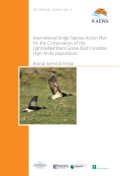 |
|
International Single Species Action Plan for the Conservation of the Northern Bald Ibis Geronticus eremitaCompiled by Maria Jose Jimenez Armesto, Christiane Boehm & Chris Bowden
Technical Series No. 10
AEWA
2006
From the executive summary: "The Northern Bald Ibis Geronticus eremita has undergone a long history of decline over at least four centuries, having been distributed over much of north and northeast Africa and the Middle East. Two distinct populations have been identified which are genetically distinct. The main western population occurs in Morocco and now numbers around 100 pairs. A relict population of two pairs persists in Syria, providing a precarious opportunity to keep the eastern population going in a truly wild state. Turkish birds are now only semi-wild, but are still a very important genetic resource for a time when reintroduction methodology has been developed further."
|
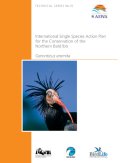 |
|
International Single Species Action Plan for the Conservation of the Corncrake Crex crexCompiled by Kees Koffijberg & Norbert Schaffer
Technical Series No. 9
AEWA
(CMS Technical Series No. 14)
2006
From the executive summary: "The Corncrake is considered 'near threatened' worldwide. It is included in Annex I of the EU Bird Directive, Appendix II of the Bern Convention and Appendix II of the Bonn Convention. Corncrakes breed widely across Eurasia, from the Atlantic to western Siberia. The core wintering area is situated in the savannas and other grasslands in eastern and south-eastern Africa. The global population is estimated to number 1.7 to 3.5 million singing males, including estimates for countries where complete national surveys are not feasible. Due to the lack of sufficient data, trends are rather poorly known in many (important) countries in the breeding range, especially in eastern Europe and Asia. Based on new information from these countries, the species recently has been downlisted from 'globally threatened' to 'near threatened'. Available data on trends suggest declines of 20-50% in the recent decades in large parts of the breeding range, most pronounced in western European countries. From the mid-1990s onwards, however, several countries have reported increases."
|
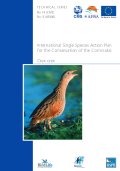 |
|
International Single Species Action Plan for the Conservation of the White-headed Duck Oxyura leucocephalaCompiled by Baz Hughes, James Robinson, Andy Green, David Li & Taej Mundkur
Technical Series No. 8
AEWA
(CMS Technical Series No. 13)
2006
From the executive summary: "The White-headed Duck is a highly aquatic diving duck of the stifftail tribe Oxyurini. Globally, there are four populations; two of which are declining, one stable and one increasing. The decreasing populations include the main Central Asian population of 5,000-10,000 birds and the Pakistan wintering population, which is on the verge of extinction. The resident North African population (400-600 birds) is stable and the Spanish population (ca. 2,500 birds) increasing. The White-headed Duck occurs regularly in 26 countries, and in another 22 as a vagrant. Nine countries hold significant breeding numbers (Algeria, Islamic Republic of Iran, Kazakhstan, Mongolia, Russian Federation, Spain, Tunisia, Turkey, and Uzbekistan), but most are concentrated in Mongolia, Kazakhstan, Russian Federation, and Spain. Birds occur commonly on migration in 10 countries, and in winter (December to February) in 13. The most important wintering countries differ from year-to-year, presumably depending on weather conditions. In recent years, 10 countries have held over 1,000 birds (Azerbaijan, Bulgaria, Greece, Islamic Republic of Iran, Israel, Kazakhstan, Russian Federation, Spain, Turkey, and Uzbekistan). Seven countries hold significant numbers of birds throughout the year (Algeria, Islamic Republic of Iran, Russian Federation, Spain, Tunisia, Turkey, and Uzbekistan)."
|
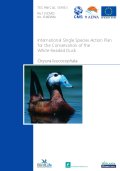 |
|
International Single Species Action Plan for the Conservation of the Ferruginous Duck Aythya nyrocaCompiled by James A. Robinson & Baz Hughes
Technical Series No. 7
AEWA
(CMS Technical Series No. 12)
2006
Prepared with co-funding from the Ministry of Ecology and Sustainable Development, France
From the executive summary: "The Ferruginous Duck is a little studied, partial migrant, widely distributed in Europe, Asia and Africa. During the first quarter of the 20 th century, it was described as one of the most plentiful Anatidae species over a great part of its range. Since then, it has undergone a large, long-term decline globally. The species is regularly recorded in 77 countries and in at least 26 others as a vagrant."
|
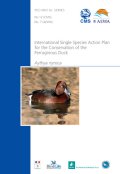 |
|
International Single Species Action Plan for the Conservation of the Great Snipe Gallinago media
Technical Series No. 5
AEWA
2004
Prepared with financial support from the Ministry of Agriculture, Nature Management and Fisheries, The Netherlands
From the summary: "At present the Great Snipe breeds in two separate areas: a western population in the Scandinavian Mountains and an eastern population from Poland throughout the Baltic States, Ukraine, Belarus and the boreal areas and bush-tundra areas in Russia eastwards to the Yenisey River in Siberia. It winters, with several stopover sites, in tropical Africa and seems to have a rapid spring and autumn migration with a few short stopovers between African wintering areas and the breeding sites. The population declined dramatically at the end of the 19th and in the first half of the 20th century, when the species disappeared from the Netherlands, Germany, Denmark, Finland and the lowlands of Sweden and Norway. During the same period there was also a considerable population reduction in Poland, the Baltic States, Ukraine, Belarus and in Russia (best documented for the southern parts)."
|
 |
|
International Single Species Action Plan for the Conservation of the Black-winged Pratincole Glareola nordmanni
Technical Series No. 4
AEWA
2004
Prepared with financial support from the Ministry of Agriculture, Nature Management and Fisheries, The Netherlands
From the summary: "The Black-winged Pratincole breeds mainly in the steppe and desert belt of Eurasia from Romania and Ukraine in the west to the Russian part of the Altai and to Kazakhstan in the east. It winters in Africa south of the Sahara desert. Migration through the Middle East countries such as Turkey, Iran, Iraq, etc. is probably transit/flyover, and takes place at high altitudes; as a result the Black-winged Pratincole is seldom recorded in this region. Population decline of the Black-winged Pratincole started in the end of 19th century, and became more evident in the second half of the 20th century. In recent years, starting from the 1980s-1990s, a marked population decline again took place: in 10 years numbers decreased by half or two thirds. Currently the total population of the Black-winged Pratincole is unlikely to exceed 10,000-15,000 pairs."
|
 |
|
Non-Toxic Shot: A Path Towards Sustainable Use Of The Waterbird ResourceCompiled by Nienke Beintema
on behalf of the UNEP/AEWA Secretaria
Technical Series No. 3
AEWA
2004?
From the introduction: "Why switch from lead shot to non-toxic shot? Why give up a traditionally used, well-known, cheap and high quality shot type in favour of anything else? Why go through all the trouble of educating and/or raising awareness amongst hunters, producing new shot types, and changing legislation all over the world? These questions are straightforward and understandable. And so is their answer: a switch to non-toxic shot is necessary to preserve waterbirds and their habitats for the future. Not only for nature conservationists, but naturally also for hunters themselves. In our modern world, where there is a constant competition between environmental and human demands, there is no other solution than to use natural resources sustainably. In the light of this, there is no other way than to abandon the use of lead shot when hunting waterbirds in wetlands."
|
 |
|
International Single Species Action Plan for the Conservation of the Sociable Lapwing Vanellus gregarius
Technical Series No. 2
AEWA
2004
Prepared with financial support from the Ministry of Agriculture, Nature Management and Fisheries, The Netherlands
From the introduction: "The Sociable Lapwing Vanellus gregarius is protected under national legislation all over its breeding range in Russia and Kazakhstan. However, the decline of species population that was observed throughout the entire 20th century - most notably at the beginning of the century, later from 1930 to 1960 and then from the 1970s to the 1990s - requires urgent measures to be undertaken by the AEWA Range States, as well as by the states that have not yet joined this international agreement, but are responsible for the survival of the Sociable Lapwing during breeding, migration and wintering."
|
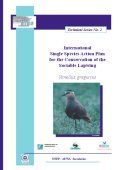 |
|
The Report on the Conservation Status of Migratory Waterbird in the Agreement Area
Technical Series No. 1
AEWA
1999
Prepared by Wetlands International for the Agreement Secretariat. Prepared with financial support from the Ministry of Agriculture, Nature Management and Fisheries, The Netherlands
"The Report on the Conservation Status of Migratory Waterbird in the Agreement Area, was published at the end of 2000. This report constitutes the first such report on the status and trend of all waterbird populations covered by the Agreement since the text of the Agreement was finalised in June 1995. It is intended to serve two purposes; firstly to fulfil the requirement in paragraph 7.4 of the Action Plan for an international review of the status and trends of the populations listed in the Action Plan, and secondly to provide the necessary information to facilitate amendment of the Action Plan to include all populations of waterbirds covered by the Agreement."
|
 |
|